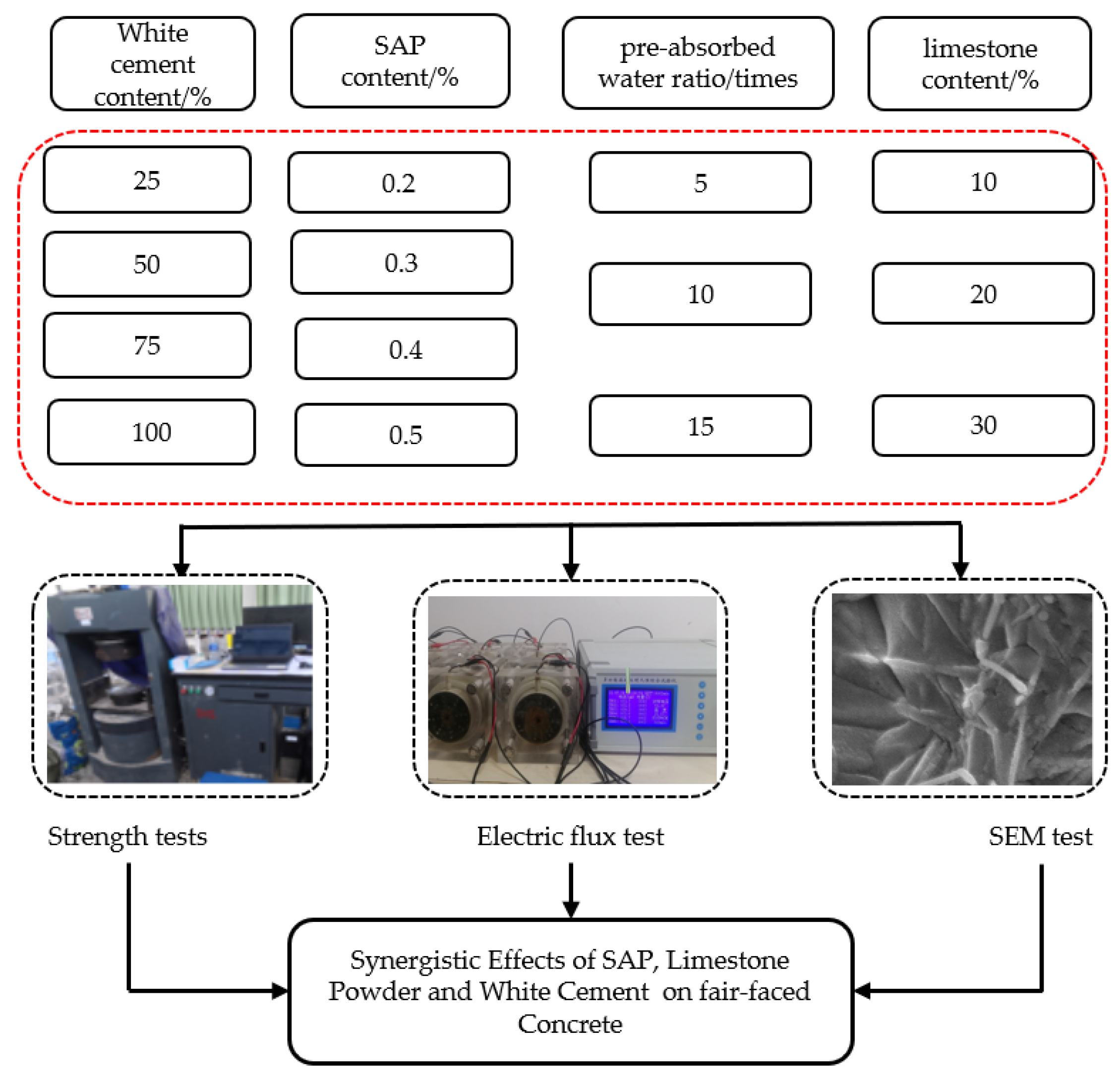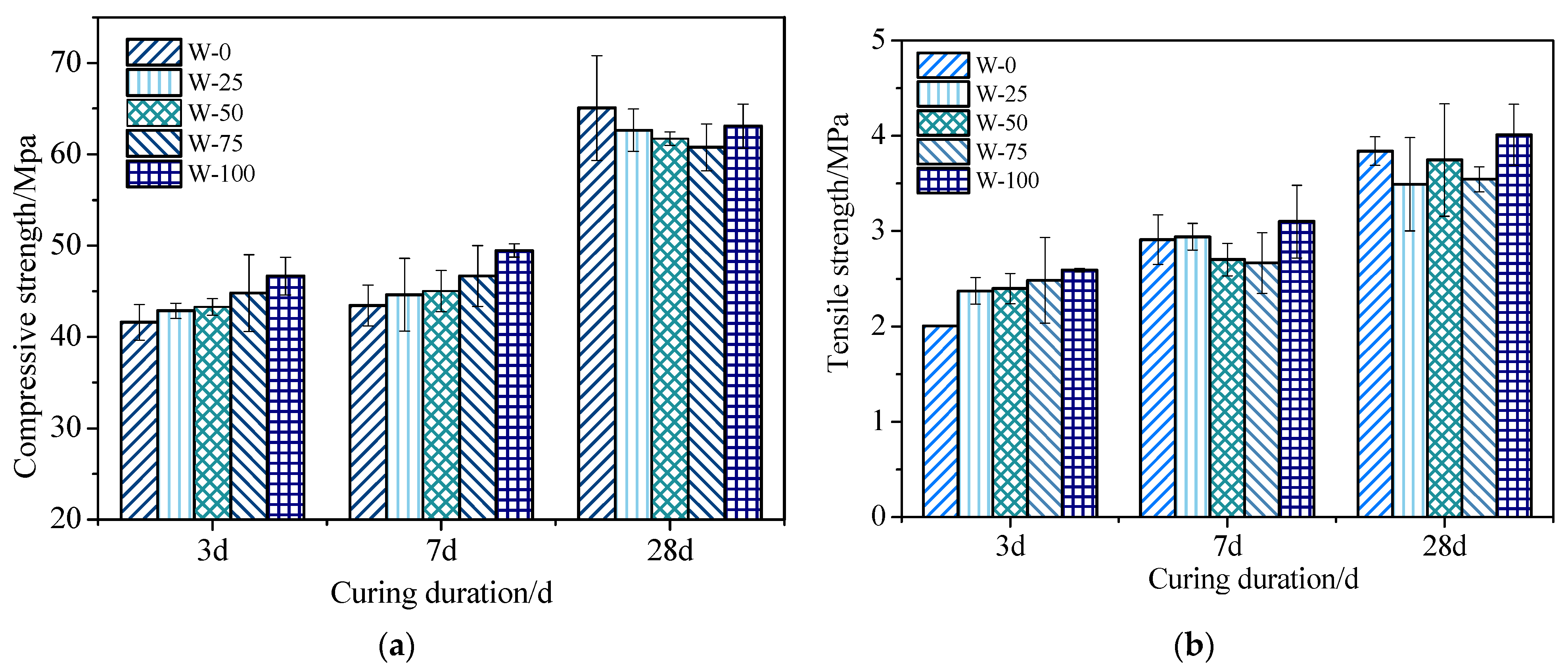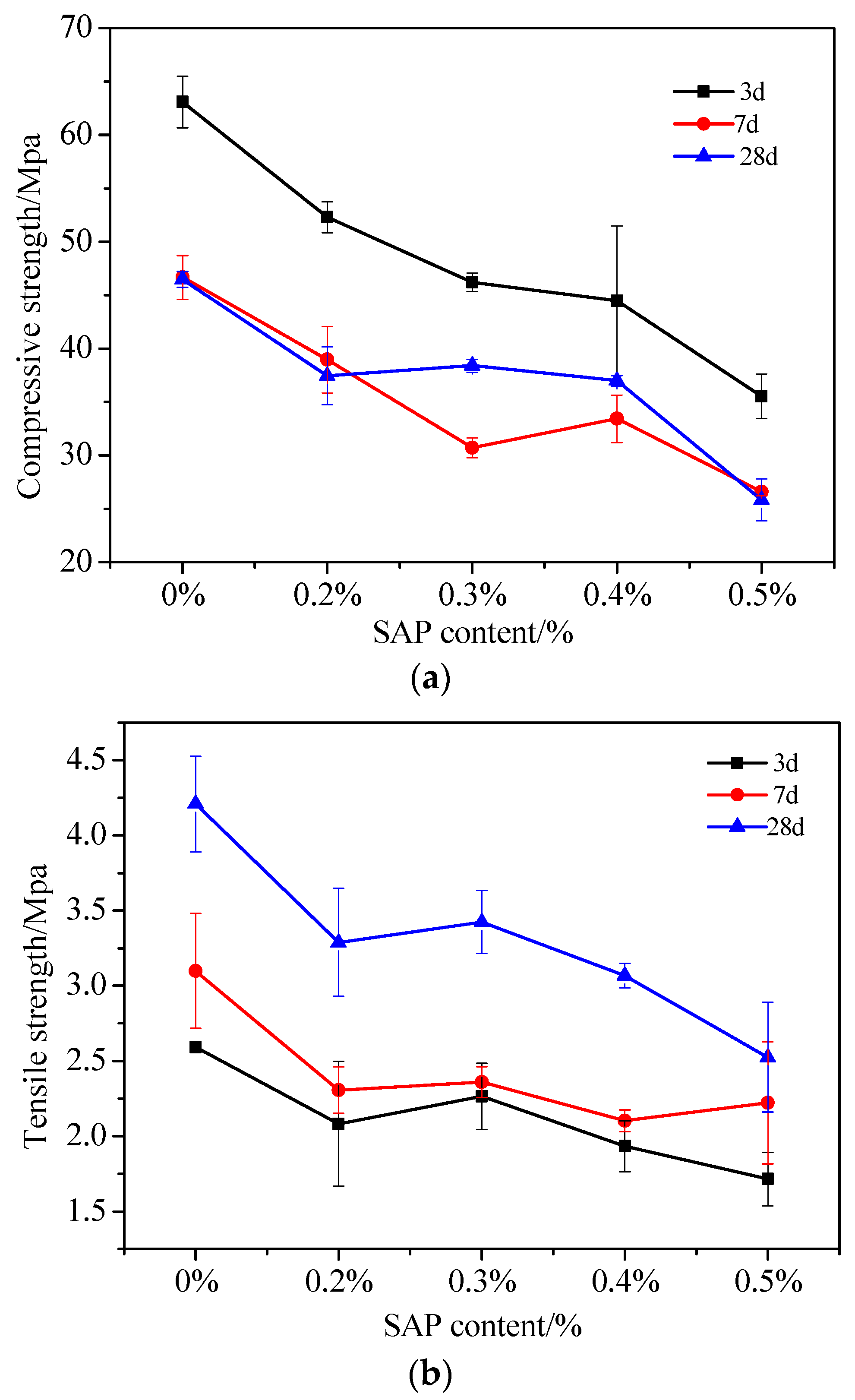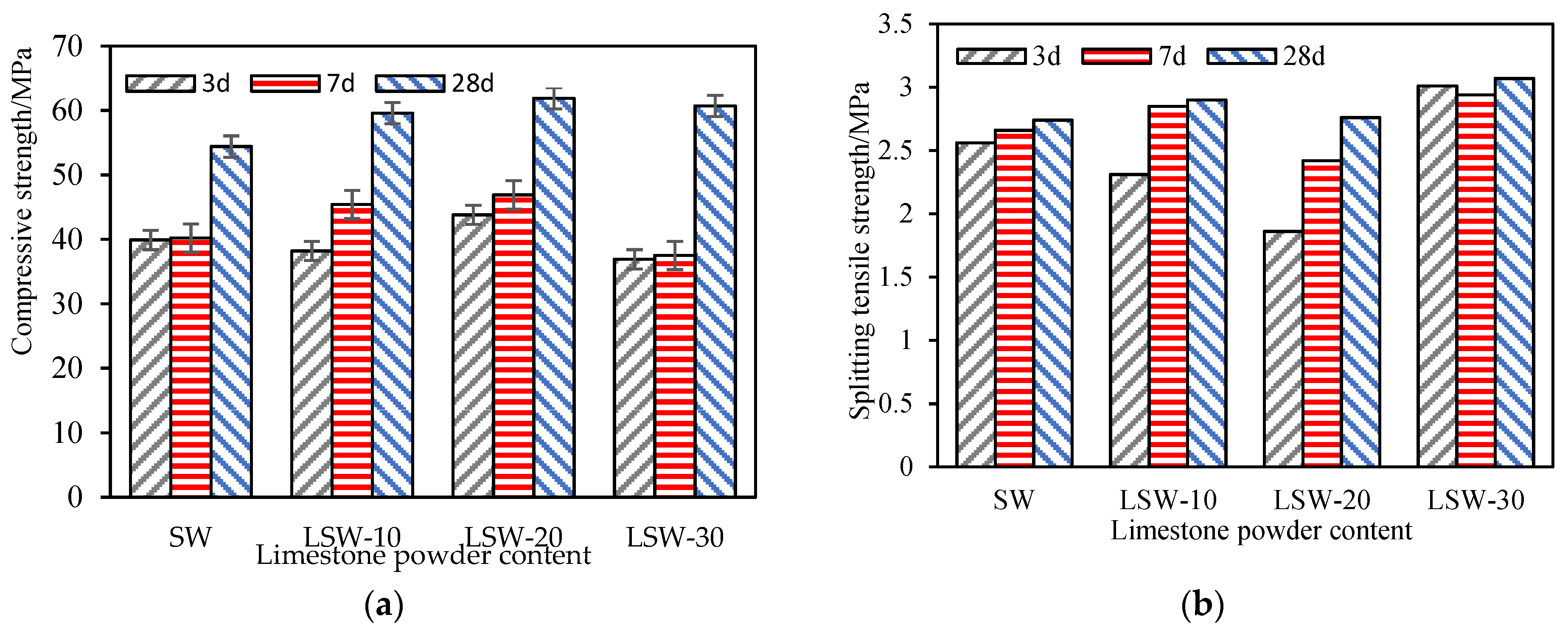Synergistic Effects of SAP, Limestone Powder and White Cement on the Aesthetic and Mechanical Properties of Fair-Faced Concrete
Abstract
:1. Introduction
2. Materials and Methods
2.1. Materials
2.1.1. Fundamental Properties of the Material
2.1.2. Mixture Design
2.2. Experimental Methods
2.2.1. Sample Preparation
2.2.2. Slump Test
2.2.3. Strength Tests
2.2.4. Rapid Chloride Permeability Test
2.2.5. Scanning Electron Microscopy Test
3. Results and Discussion
3.1. Influence of SAP, Limestone, and White Cement on Fair-Faced Concrete
3.1.1. Effect on Workability
- (1)
- The impact of SAP on the workability of fair-faced concrete
- (2)
- The impact of water absorption on the workability of fair-faced concrete
- (3)
- The impact of limestone on the workability of fair-faced concrete
3.1.2. Impact on Durability
- (1)
- Impact of white cement on the durability of fair-faced concrete
- (2)
- Impact of SAP on the durability of fair-faced concrete
- (3)
- Impact of limestone on the durability of fair-faced concrete
3.1.3. Impact on Mechanical Properties
- (1)
- Influence of white cement on the strength of fair-faced concrete
- (2)
- Effect of SAP content on the mechanical properties of fair-faced concrete
- (3)
- Effect of SAP water absorption ratio on fair-faced concrete
- (4)
- Effect of limestone powder on the mechanical properties of fair-faced concrete
3.1.4. ANOVA Analysis of the Influence of Various Factors
3.2. Effects on Color and Appearance of Fair-Faced Concrete
3.2.1. Impact of White Cement on the Color of Concrete
3.2.2. Impact of SAP and Limestone Powder on the Appearance of Concrete
3.2.3. Color Difference Quantitative Analysis
3.3. Microstructural Analysis of Fair-Faced Concrete Using SEM
3.3.1. Results of SEM
3.3.2. Microscopic Interpretation of Macroscopic Performance
- (1)
- Microstructure and mechanical properties
- (2)
- Microstructure and durability
- (3)
- Microstructure and impermeability
3.3.3. Relationship between Microstructure and Aesthetic Properties
- (1)
- Microstructure of SAP and Fair-Faced Concrete
- (2)
- Microstructure of Fair-faced Concrete with Limestone Powder
- (3)
- Relationship between Microstructure and Aesthetic Properties
3.3.4. Relationship between Microstructure and Mechanical Properties
- (1)
- Influence of SAP on the Microstructure of Fair-faced Concrete
- (2)
- Effect of Limestone Powder on the Microstructure of Fair-faced Concrete
- (3)
- Relationship between Microstructure and Mechanical Properties
4. Conclusions
- (1)
- The Superabsorbent Polymer (SAP) is pivotal in white cement fair-faced concrete. This is largely attributed to its ability to regulate the hydration of the concrete, especially in the early stages. By gradually releasing moisture during the curing process, SAP ensures continuous hydration of the cement. This is crucial as white cement, while enhancing the color vibrancy of concrete, has an accelerated hydration rate that could lead to early-stage cracks. By mitigating this challenge, SAP ensures the longevity and workability of the concrete. Through extensive testing and evaluations, SAP content of 0.3% has emerged as the optimal proportion for delivering superior concrete performance.
- (2)
- Limestone powder serves a dual purpose in the realm of fair-faced concrete. Firstly, as a mineral admixture, it significantly bolsters the mechanical properties of the Concrete, acting as a fortifying agent. Secondly, its presence refines the concrete’s microstructure, as evidenced by Scanning Electron Microscopy (SEM) evaluations. These microscopic evaluations have unveiled the profound impact of limestone powder on the concrete’s performance metrics. Through a series of experiments, a combination of 30% limestone powder content with 0.3% SAP has been determined to provide the optimal comprehensive performance for the concrete.
- (3)
- The beauty of fair-faced concrete is not just skin-deep. Its aesthetic properties are intricately linked to its microstructure. The uniformity, color vibrancy, and overall aesthetic appeal of the concrete are significantly dictated by the fine-tuning of its microstructure. By optimizing the proportions of SAP and limestone powder, not only is the mechanical robustness of the concrete enhanced, but its aesthetic appeal also sees marked improvement.
- (4)
- The results of the ANOVA reinforce the observations made in the previous sections. The significant p-values associated with the factors underscore their influence on the properties of fair-faced concrete. For instance, the significance of SAP concentration aligns with its observed effect on workability and microstructure. Similarly, the importance of limestone content in enhancing mechanical strengths is statistically validated.
- (5)
- This investigation is more than just a theoretical exploration; it holds pragmatic value. By shedding light on the synergistic effects of SAP, limestone powder, and white cement, the research offers invaluable insights into the optimal formulations for white cement fair-faced concrete. These findings are not just academically significant but hold substantial relevance for real-world engineering applications. Architects, civil engineers, and construction professionals can leverage these insights to produce superior quality fair-faced concrete, combining aesthetic appeal with mechanical robustness.
Author Contributions
Funding
Institutional Review Board Statement
Informed Consent Statement
Data Availability Statement
Conflicts of Interest
References
- Cai, C.Q.; Guo, Q.S.; Li, X. Experimental research on durability of fair-faced concrete. Adv. Mater. Res. 2012, 535–537, 1693–1696. [Google Scholar] [CrossRef]
- Károlyfi, K.A.; Papp, F. Laboratory study of the effect of saturation degree on quality of fair-faced concrete surfaces. Építöanyag 2021, 1, 115–118. [Google Scholar]
- Cao, Z.; Miao, J.; Hou, X. Inheritance of Traditional Culture in Modern Architecture: Product Analysis of the Tadao Ando and Wangchuk. Hua Zhong Arch. 2014, 6, 30–35. [Google Scholar]
- Lan, M.; Wang, H.; Chen, Z.; Ge, Z.; Wang, J.; Pei, T. Physical and Mechanical Properties and Hydration of High Belite Sulphoaluminate Cement Modified White Cement. Bull. Chin. Ceram. Soc. 2021, 40, 3345–3351. [Google Scholar]
- IR, W.G. White cement-properties, manufacture, prospects. Ceram. Silikáty 2001, 45, 158–163. [Google Scholar]
- Yang, D.; Cao, C.; Xia, J.; Zhou, Y.; Wang, W.; Guan, Q. Research on the Application of White Portland Cement in Mass Concrete. Constr. Technol. 2022, 51, 107–111. [Google Scholar]
- Hamad, B.S. Investigations of chemical and physical properties of white cement concrete. Adv. Cem. Based Mater. 1995, 2, 161–167. [Google Scholar] [CrossRef]
- Megid, W.A.; Khayat, K.H. Methodology to evaluate variations in concrete color caused by white cement substitutions and forming materials. Mater. Struct. 2020, 53, 1–15. [Google Scholar] [CrossRef]
- Albo Portland (Anqing) Co., Ltd. The latest application trends of white cement. China Cem. 2022, 38, 10. [Google Scholar]
- Kuhn, D.C.; Cabral, L.L.; Pereira, I.C.; Gonçalves, A.J.; Maciel, G.M.; Haminiuk, C.W.; Nagalli, A.; Passig, F.H.; de Carvalho, K.Q. Development of aerated concrete waste/white cement composite for phosphate adsorption from aqueous solutions: Characterization and modeling studies. Chem. Eng. Process.-Process Intensif. 2023, 184, 109284. [Google Scholar] [CrossRef]
- Ashteyat, A.M.; Al Rjoub, Y.S.; Murad, Y.; Asaad, S. Mechanical and durability behaviour of roller-compacted concrete containing white cement by pass dust and polypropylene fibre. Eur. J. Environ. Civ. Eng. 2022, 26, 166–183. [Google Scholar] [CrossRef]
- Liu, X. A Preparation Method of C40 High Performance White Fair-Faced Concrete. Build. Constr. 2022, 44, 6. [Google Scholar]
- Wang, L.; Zhang, L. Research Progress on Concrete Internal Curing Technology. J. Build. Mater. 2020, 23, 1471–1478. [Google Scholar]
- Han, Y.; Zhang, J.; Luosun, Y.; Hao, T. Effect of internal curing on internal relative humidity and shrinkage of high strength concrete slabs. Constr. Build. Mater. 2014, 61, 41–49. [Google Scholar] [CrossRef]
- Pourjavadi, A.; Fakoorpoor, S.M.; Khaloo, A.; Hosseini, P. Improving the performance of cement-based composites containing superabsorbent polymers by utilization of nano-SiO2 particles. Mater. Des. 2012, 42, 94–101. [Google Scholar] [CrossRef]
- Morinaga, Y.; Akao, Y.; Fukuda, D.; Elakneswaran, Y. Delayed Absorption Superabsorbent Polymer for Strength Development in Concrete. Materials 2022, 15, 2727. [Google Scholar] [CrossRef] [PubMed]
- Shen, D.; Shi, H.; Tang, X.; Ji, Y.; Jiang, G. Effect of internal curing with super absorbent polymers on residual stress development and stress relaxation in restrained concrete specimens. Constr. Build. Mater. 2016, 120, 309–320. [Google Scholar] [CrossRef]
- Wei, Y.; Zheng, X.; Guo, W. Shrinkage, strength development and cracking of internally cured concrete exposed to dry conditions. J. Build. Mater. 2016, 19, 902–908. [Google Scholar]
- Liu, J. Effects of SAP characteristics on internal curing of UHPC matrix. Constr. Build. Mater. 2021, 280, 122530. [Google Scholar] [CrossRef]
- Jensen, O.M.; Hansen, P.F. Water-entrained cement-based materials: Implementation and experimental results. Cem. Concr. Res. 2002, 32, 973–978. [Google Scholar] [CrossRef]
- Xie, F.; Zhang, C.; Cai, D.; Ruan, J. Comparative study on the mechanical strength of SAP internally cured concrete. Front. Mater. 2020, 7, 588130. [Google Scholar] [CrossRef]
- Assmann, A. Physical Properties of Concrete Modified with Superabsorbent Polymers. Ph.D. Thesis, Stuttgart University, Stuttgart, Germany, 2013. [Google Scholar]
- Qin, X.; Shen, A.; Yu, Z.; Shi, L.; Yang, J.; Liu, H. Research on water transport behavior and hydration characteristics of internal curing pavement concrete. Constr. Build. Mater. 2020, 248, 118714. [Google Scholar] [CrossRef]
- Kang, S.H.; Hong, S.G.; Moon, J. Shrinkage characteristics of heat-treated ultra-high-performance concrete and its mitigation using superabsorbent polymer based internal curing method. Cem. Concr. Compos. 2018, 89, 130–138. [Google Scholar] [CrossRef]
- Pang, L.; Ruan, S.; Cai, Y. Effects of internal curing by superabsorbent polymer on shrinkage of concrete. Key Eng. Mater. 2011, 477, 200–204. [Google Scholar] [CrossRef]
- Lauch, K.S.; Charron, J.P.; Desmettre, C. Comprehensive evaluation of self-healing of concrete with different admixtures under laboratory and long-term outdoor expositions. J. Build. Eng. 2022, 54, 104661. [Google Scholar] [CrossRef]
- Zhong, P. Study on the Autogenous Shrinkage and Mechanism of High Strength Concrete with Superabsorbent Polymer. Ph.D. Thesis, Chongqing University, Chongqing, China, 2015. [Google Scholar]
- Craeye, B.; Geirnaert, M.; De Schutter, G. Absorbing polymers as an internal curing agent for mitigation of early-age cracking of high-performance concrete bridge decks. Constr. Build. Mater. 2011, 25, 1–13. [Google Scholar] [CrossRef]
- Wang, L. Research progress on internal curing concrete. Concrete 2014, 5, 30–34. [Google Scholar]
- Shi, C.; Lyu, K.; Ma, X.; Zhang, J.; Liu, J. Influence of SAP on the properties of self-compacting concrete. Mater. Rep. 2015, 29, 118–129. [Google Scholar]
- Xie, H.; Zhang, Y.; Luan, J. Influence of Limestone Powder on Properties of Concrete Prepared from Cement and Fly ash. Bull. Chin. Ceram. Soc. 2012, 31, 371–376. [Google Scholar]
- Wang, D.; Shi, C.; Farzadnia, N.; Shi, Z.; Jia, H. A review on effects of limestone powder on the properties of concrete. Constr. Build. Mater. 2018, 92, 153–166. [Google Scholar] [CrossRef]
- Sezer, G.I. Compressive strength and sulfate resistance of limestone and/or silica fume mortars. Constr. Build. Mater. 2012, 26, 613–661. [Google Scholar] [CrossRef]
- Li, L.G.; Kwan, A. Adding limestone fines as cementitious paste replacement to improve tensile strength, stiffness and durability of concrete. Cem. Concr. Compos. 2015, 60, 17–24. [Google Scholar] [CrossRef]
- Schöler, A.; Lothenbach, B.; Winnefeld, F.; Zajac, M. Hydration of quaternary Portland cement blends containing blast-furnace slag, siliceous fly ash and limestone powder. Cem. Concr. Compos. 2015, 55, 374–382. [Google Scholar] [CrossRef]
- Tongaroonsri, S.; Tangtermsirikul, S. Effect of mineral admixtures and curing periods on shrinkage and cracking age under restrained condition. Constr. Build. Mater. 2009, 23, 1050–1056. [Google Scholar] [CrossRef]
- Chen, J.; Kwan, A.; Jiang, Y. Adding limestone fines as cement paste replacement to reduce water permeability and sorptivity of concrete. Constr. Build. Mater. 2014, 56, 87–93. [Google Scholar] [CrossRef]
- Khan, R.A.; Gupta, C. A review on the study of self curing concrete. Int. Res. J. Eng. Technol. 2020, 11, 1–7. [Google Scholar]
- Dang, J.; Zhao, J.; Du, Z. Effect of superabsorbent polymer on the properties of concrete. Polymers 2017, 9, 672. [Google Scholar] [CrossRef]
- Dhandapani, Y.; Santhanam, M.; Kaladharan, G.; Ramanathan, S. Towards ternary binders involving limestone additions—A review. Cem. Concr. Res. 2021, 143, 106396. [Google Scholar] [CrossRef]
- He, J.; Wang, S.; Du, J.; Lv, X.; Liu, J. Preparation and construction technology of super large area fair-faced concrete structure. Concrete 2006, 6, 77–79. [Google Scholar]
- Iu, Y.; Jiang, T.; Zhao, J.; Wang, X.; Du, Y.; Xu, T. Mix Proportion Design of Low-Quality Recycled Aggregate Self-compacting as-cast-finish Based on Orthogonal Experiment. Constr. Technol. 2021, 50, 134–137. [Google Scholar]
- Zhang, P. Design and construction quality control for as-cast finish concrete. Concrete 2014, 8, 107–110. [Google Scholar]
- He, Z.; Shen, A.; Guo, Y.; Lyu, Z.; Li, D.; Qin, X.; Zhao, M.; Wang, Z. Cement-Based materials modified with super absorbent polymers: A review. Constr. Build. Mater. 2019, 225, 569–590. [Google Scholar] [CrossRef]
- Montanari, L.; Suraneni, P.; Weiss, W.J. Accounting for water stored in super absorbent polymers increases the degree of hydration and reduces the shrinkage of internally cured cementitious mixtures. Adv. Civ. Eng. Mater. 2019, 6, 583–599. [Google Scholar]
- Bentz, D.P.; Snyder, K.A. Protected paste volume in concrete: Extension to internal curing using saturated lightweight fine aggregate. Cem. Concr. Res. 2019, 29, 1863–1867. [Google Scholar] [CrossRef]
- Liangying, L.; Hao, L.; Qiao, H.; Jianjun, J. Preparation and Parameter Optimization of the Maintenance Agent in the High Absorbent Resin Used in Concrete. J. Lanzhou Jiaotong Univ. 2021, 40, 1–6. [Google Scholar]
- Gao, X.; He, R. Influence of super absorbent polymer on concrete strength and hydration process. J. Highw. Transp. Res. Dev. 2018, 35, 34–39. [Google Scholar]
- Zhang, Y.; Ye, H.; Zhao, J. Study of Workable and Adhesion Properties of Building Mortar Modified by Superabsorbent Resins. Chem. Build. Mater. 2004, 5, 53–59. [Google Scholar]
- GB/T50080-2016; Standards for Performance Tests of Ordinary Concrete Mixtures. National Standard of the People’s Republic of China. China Construction Industry Press: Beijing, China, 2016.
- GB/T50081-2002; Standard for Test Methods of Mechanical Properties of Ordinary Concrete. National Standard of the People’s Republic of China, China Construction Industry Press: Beijing, China, 2002.
- GBT50082-2009; Standard for Test Methods for Long-Term Performance and Durability of Ordinary Concrete. National Standard of the People’s Republic of China. China Construction Industry Press: Beijing, China, 2009.
- JGJ/T193-2009; Standard for Inspection and Assessment of Concrete Durability. Ministry of Housing and Urban Rural Development of the People’s Republic of China: Beijing, China, 2009.
- Ding, H.; Gao, Y.; Xu, F.; Wu, H.Y.; Yin, X.B. Experimental Study on C60 High-Performance White Clear Water Concrete. J. New Build. Mater. 2012, 39, 83–86. [Google Scholar]
- Shen, A.Q.; Yang, J.Y.; Guo, Y.C.; Qin, X.; Li, P. A Review of Self-healing Concrete with SAP. J. Transp. Eng. 2021, 21, 1–31. [Google Scholar]
- Meng, F.; Chen, Y.; Fan, Y. Research and Engineering Application of C25 White Cement Fair-Faced Concrete. Arch. Technol. 2020, 51, 1453–1455. [Google Scholar]
- Li, W.; Huang, Z.; Cao, F.; Sun, Z.; Shah, S.P. Effects of nano-silica and nano-limestone on flowability and mechanical properties of ultra-high-performance concrete matrix. Constr. Build. Mater. 2015, 95, 366–374. [Google Scholar] [CrossRef]
- Huo, J.; Song, M.; Tong, Z.; Cui, Q.; Pan, H. Effect of limestone admixture on performance of concrete. Concrete 2015, 5, 70–72. [Google Scholar]
- Ghafoori, N.; Spitek, R.; Najimi, M. Influence of limestone size and content on transport properties of self-consolidating concrete. Constr. Build. Mater. 2016, 127, 588–595. [Google Scholar] [CrossRef]
- Revilla-Cuesta, V.; Skaf, M.; Espinosa, A.B.; Santamaría, A.; Ortega-López, V. Statistical Approach for the Design of Structural Self-Compacting Concrete with Fine Recycled Concrete Aggregate. Mathematics 2020, 8, 2190. [Google Scholar] [CrossRef]
- Han, Y.; Zhu, H.; Zhang, Y.; Yang, Z. Accelerating Carbonation Degree and Microstructure of Surface Layer of Hardened White Portland Cement. J. Build. Mater. 2022, 25, 968–975. [Google Scholar]
- Weber, P. Black Fair-Faced Concrete: Coloring Concrete by the Proper Means. Betonw. Fert.-Tech. 2008, 74, 7. [Google Scholar]










| Component | CaO | SiO2 | Al2O3 | MgO | Fe2O3 | K2O | LOI |
|---|---|---|---|---|---|---|---|
| White Portland Cement | 62.79 | 20.75 | 3.22 | 2.53 | 0.25 | 1.34 | 1.96 |
| Ordinary Portland Cement | 52.84 | 14.24 | 5.41 | 1.80 | 2.46 | 0.89 | 9.87 |
| Fly ash | 3.32 | 39.80 | 28.99 | 0.52 | 4.28 | 1.31 | 21.28 |
| Materials | Particle Size (mm) | Deionized Water Absorption (g/g) | Pre-Absorbed Water Ratio (s) | PH | Volume Density (g/cm3) |
|---|---|---|---|---|---|
| SAP | 0.25–0.6 | ≥200 | ≤60 s | 6~7 | 0.6~0.9 |
| Label | Ordinary Cement | White Cement | Limestone Powder | SAP | Fly Ash | Pre-Absorbed Water | Gravel | Sand | Water | Water Reducer |
|---|---|---|---|---|---|---|---|---|---|---|
| W-0 | 317 | 0 | 0 | 0 | 133 | 0 | 1083 | 752 | 150 | 4.6 |
| W-25 | 237.75 | 79.25 | 0 | 0 | 133 | 0 | 1083 | 752 | 150 | 4.6 |
| W-50 | 158.5 | 158.5 | 0 | 0 | 133 | 0 | 1083 | 752 | 150 | 4.6 |
| W-75 | 79.25 | 237.75 | 0 | 0 | 133 | 0 | 1083 | 752 | 150 | 4.6 |
| W-100 | 0 | 317 | 0 | 0 | 133 | 0 | 1083 | 752 | 150 | 4.6 |
| SW-0.2 | 158.5 | 158.5 | 0 | 0.9 | 133 | 9 | 1083 | 752 | 150 | 4.6 |
| SW-0.3 | 0 | 317 | 0 | 1.35 | 133 | 13.5 | 1083 | 752 | 150 | 4.6 |
| SW-0.4 | 0 | 317 | 0 | 1.8 | 133 | 18 | 1083 | 752 | 150 | 4.6 |
| SW-0.5 | 0 | 317 | 0 | 2.25 | 133 | 22.5 | 1083 | 752 | 150 | 4.6 |
| SW-5 | 158.5 | 158.5 | 0 | 0.9 | 133 | 9 | 1083 | 752 | 150 | 4.6 |
| SW-10 | 158.5 | 158.5 | 0 | 0.9 | 133 | 9 | 1083 | 752 | 150 | 4.6 |
| SW-15 | 158.5 | 158.5 | 0 | 0.9 | 133 | 9 | 1083 | 752 | 150 | 4.6 |
| LSW-10 | 136 | 136 | 45 | 0.9 | 133 | 9 | 1083 | 752 | 150 | 4.6 |
| LSW-20 | 113.5 | 113.5 | 90 | 0.9 | 133 | 9 | 1083 | 752 | 150 | 4.6 |
| LSW-30 | 91 | 91 | 135 | 0.9 | 133 | 9 | 1083 | 752 | 150 | 4.6 |
| Level | I | II | III | IV | V |
|---|---|---|---|---|---|
| Electric Flux (Qs)/C | Qs ≥ 4000 | 2000 ≤ Qs ˂ 4000 | 1000 ≤ Qs ˂ 2000 | 500 ≤ Qs ˂ 1000 | Qs ˂ 500 |
| P | Compressive Strength/MPa | Tensile Strength/MPa | RCPT Value/c | Slump/mm | ||||
|---|---|---|---|---|---|---|---|---|
| 3 d | 7 d | 28 d | 3 d | 7 d | 28 d | |||
| White Cement Content | 0.6971 | 0.8212 | 0.0925 | 0.3494 | 0.1692 | 0.0633 | 0.4096 | 0.7844 |
| SAP Content | 0.0388 | 0.0064 | 0.0000 | 0.0305 | 0.1330 | 0.0093 | 0.1348 | 0.0036 |
| Pre-Absorbed Water Ratio | 0.2364 | 0.5315 | 0.8232 | 0.2010 | 0.6324 | 0.0590 | 0.0001 | 0.2276 |
| Limestone Content | 0.1875 | 0.6372 | 0.0003 | 0.1632 | 0.4195 | 0.7516 | 0.0537 | 0.0031 |
Disclaimer/Publisher’s Note: The statements, opinions and data contained in all publications are solely those of the individual author(s) and contributor(s) and not of MDPI and/or the editor(s). MDPI and/or the editor(s) disclaim responsibility for any injury to people or property resulting from any ideas, methods, instructions or products referred to in the content. |
© 2023 by the authors. Licensee MDPI, Basel, Switzerland. This article is an open access article distributed under the terms and conditions of the Creative Commons Attribution (CC BY) license (https://creativecommons.org/licenses/by/4.0/).
Share and Cite
Shi, J.; Wu, Z.; Zhuang, J.; Zhang, F.; Zhu, T.; Li, H. Synergistic Effects of SAP, Limestone Powder and White Cement on the Aesthetic and Mechanical Properties of Fair-Faced Concrete. Materials 2023, 16, 7058. https://doi.org/10.3390/ma16217058
Shi J, Wu Z, Zhuang J, Zhang F, Zhu T, Li H. Synergistic Effects of SAP, Limestone Powder and White Cement on the Aesthetic and Mechanical Properties of Fair-Faced Concrete. Materials. 2023; 16(21):7058. https://doi.org/10.3390/ma16217058
Chicago/Turabian StyleShi, Jun, Zhangbao Wu, Jinping Zhuang, Fan Zhang, Tongran Zhu, and Huixia Li. 2023. "Synergistic Effects of SAP, Limestone Powder and White Cement on the Aesthetic and Mechanical Properties of Fair-Faced Concrete" Materials 16, no. 21: 7058. https://doi.org/10.3390/ma16217058
APA StyleShi, J., Wu, Z., Zhuang, J., Zhang, F., Zhu, T., & Li, H. (2023). Synergistic Effects of SAP, Limestone Powder and White Cement on the Aesthetic and Mechanical Properties of Fair-Faced Concrete. Materials, 16(21), 7058. https://doi.org/10.3390/ma16217058






